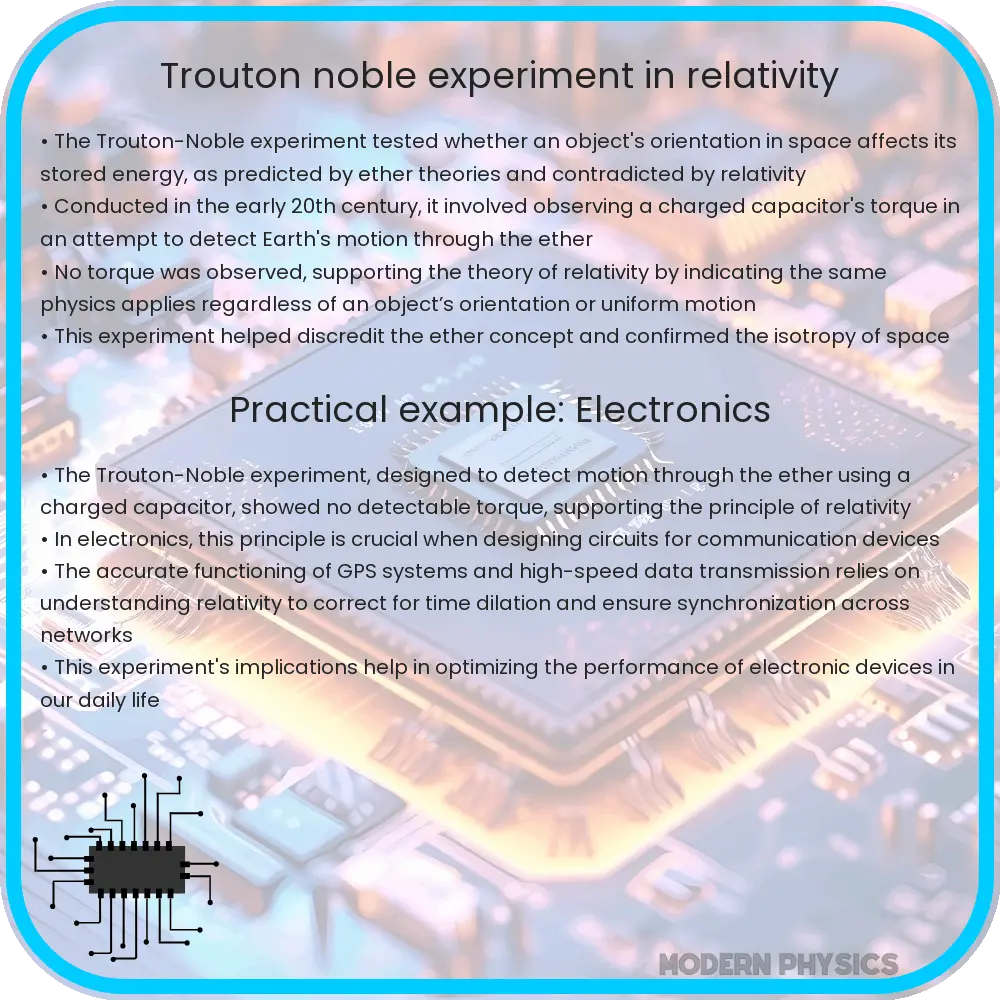Explore the Trouton-Noble Experiment and its impact on relativity and physics, revealing how null results can lead to groundbreaking insights.

Understanding the Trouton-Noble Experiment: A Cornerstone in Relativity
The Trouton-Noble experiment, conducted in the early 20th century, plays a pivotal role in understanding the principles of relativity and the Lorentz force. This experiment, designed by Frederick Trouton and H. R. Noble, aimed to detect the relative motion of the Earth through the ether, a hypothetical medium believed to carry light waves. The outcome of their work provided crucial insights into the nature of electromagnetic forces and laid the groundwork for modern physics, particularly Einstein’s theory of relativity.
The Experimental Setup
At the heart of the Trouton-Noble experiment was a simple yet ingenious setup. They suspended a charged capacitor in a torsion balance, a device sensitive to minute torques. The expectation was that, as the Earth moved through the ether, the motion would generate a Lorentz force on the capacitor’s plates, causing a detectable twist. This force, mathematically described as \[ F = q(E + v \times B) \], where q is the charge, E is the electric field, v is the velocity through the ether, and B is the magnetic field, was the cornerstone of their hypothesis.
Results and Implications
Contrary to expectations, Trouton and Noble observed no significant torque on the capacitor. This null result was initially puzzling but later gained profound significance in the context of Einstein’s special theory of relativity. According to relativity, the laws of physics, including electromagnetism, are the same in all inertial frames of reference. Therefore, an observer moving with the capacitor would not detect any ether wind or Lorentz force acting on it. The Trouton-Noble experiment inadvertently supported this radical idea, suggesting that the ether, as a medium for light waves, did not exist.
Lorentz Force and Its Role
The Lorentz force equation, central to the experiment’s hypothesis, describes the force exerted on a point charge due to electromagnetic fields. In the context of the Trouton-Noble experiment, it was hypothesized that this force would manifest as a torque on the suspended capacitor. However, the absence of this torque underlined the relative nature of motion in electromagnetism and further questioned the concept of a stationary ether.
This experiment’s findings were crucial in shifting scientific understanding from classical to relativistic physics, marking a significant moment in the history of physics.
The Role of Special Relativity in the Trouton-Noble Experiment
The Trouton-Noble experiment’s null results played a significant role in validating Einstein’s special theory of relativity. This theory, which emerged shortly after the experiment, proposed that the speed of light is constant in all inertial frames and that there is no absolute frame of reference, such as the ether. The experiment’s failure to detect any ether drift or Lorentz force on the capacitor was in line with Einstein’s postulates. It underscored that measurements of time and space are relative to the observer’s motion, fundamentally changing our understanding of physics.
Further Scientific Implications
Beyond its immediate implications for relativity, the Trouton-Noble experiment influenced other areas of physics. It highlighted the need for a consistent theory that could explain electromagnetic phenomena without relying on the ether. This paved the way for the development of quantum mechanics, which further revolutionized our understanding of the micro-world. The principles examined in the Trouton-Noble experiment continue to underpin much of modern physics, from particle physics to cosmology.
Modern Perspectives on the Experiment
In contemporary physics, the Trouton-Noble experiment is often revisited in educational contexts to illustrate the principles of relativity and the scientific method. Its methodology and conclusions are discussed in the context of experimental design and the interpretation of null results. The experiment serves as a powerful example of how unexpected results can lead to significant scientific breakthroughs.
Conclusion
The Trouton-Noble experiment, despite its initial perception as a failure, holds a place of high importance in the history of physics. By yielding a null result, it challenged the prevailing notions of the ether and motion, indirectly supporting the revolutionary concepts of Einstein’s relativity. Its legacy lies not only in its contribution to the shift from classical to modern physics but also in its testament to the scientific process. It demonstrates that in science, even a lack of expected results can profoundly impact our understanding of the universe. The experiment’s insights continue to resonate in contemporary physics, highlighting the enduring nature of scientific inquiry and discovery.
Is this conversation helpful so far?
